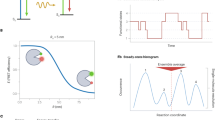Abstract
Fluorescence resonance energy transfer is a suitable approach for observing conformational changes in biomolecules, as it is a “spectroscopic molecular ruler” sensitive to nanometer-scale distances. The experimental outcomes of FRET measurements in ensemble studies provide averaged overpopulation that could hide the details of dynamics for individual molecules. Though ensemble measurements have much application and have their advantages, including easy optical setup, easy sample preparation, etc., single-molecule methods have appeared as popular and powerful tools for the understanding of complex biophysical processes. This is because of its unique abilities to probe the molecular structure, function, and dynamics from information obtained from every individual molecule. At present, several laboratories around the world employ this technique for studying various biological systems such as cells, nucleosomes as well as important biomolecular interactions between DNA, RNA, and proteins. Single-molecule FRET assays are also widely used for studying DNA hybridization, interactions between DNA–protein, protein–protein, and protein folding, etc. The dynamic changes induced on DNA/protein substrate can easily be monitored in real-time observations.
Access this chapter
Tax calculation will be finalised at checkout
Purchases are for personal use only
Similar content being viewed by others
References
Stokes GG (1852) XXX. On the change of refrangibility of light. Philos Trans R Soc Lond 142:463–562
Lakowicz JR (1983) Principles of fluorescence spectroscopy. Plenum Press, New York. 496 pp
Jabłoński A (1935) Über den mechanismus der Photolumineszenz von Farbstoffphosphoren. Z Phys 94(1–2):38–46
Lakowicz JR (2013) Principles of fluorescence spectroscopy. Springer
Sahoo H (2011) Förster resonance energy transfer–A spectroscopic nanoruler: principle and applications. J Photochem Photobiol C: Photochem Rev 12(1):20–30
Paul T, Bera SC, Mishra PP (2017) Direct observation of breathing dynamics at the mismatch induced DNA bubble with nanometre accuracy: a smFRET study. Nanoscale 9(18):5835–5842
Ha T et al (1999) Polarization spectroscopy of single fluorescent molecules. ACS Publications
Weiss VH et al (2000) The structure and oligomerization of the yeast arginine methyltransferase, Hmt1. Nat Struct Mol Biol 7(12):1165–1171
Ha T (2001) Single-molecule fluorescence methods for the study of nucleic acids. Curr Opin Struct Biol 11(3):287–292
Lakowicz JR, Masters BR (2008) Principles of fluorescence spectroscopy. J Biomed Opt 13(2):029901
Selvin PR (2000) The renaissance of fluorescence resonance energy transfer. Nat Struct Mol Biol 7(9):730
Ha T (2001) Single-molecule fluorescence resonance energy transfer. Methods 25(1):78–86
Clegg RM (1992) [18] Fluorescence resonance energy transfer and nucleic acids. Methods Enzymol 211:353–388
Weiss S (1999) Fluorescence spectroscopy of single biomolecules. Science 283(5408):1676–1683
Bandyopadhyay D, Mishra PP (2020) Real-time monitoring of the multistate conformational dynamics of polypurine reverse Hoogsteen hairpin to capture their triplex-affinity for gene silencing by smFRET microspectroscopy. J Phys Chem B 124(38):8230–8239
Mondal S, Mishra PP (2021) Direct observation of effect of crowding induced macromolecular hydration on molecular breathing in the stem of Fork-DNA by single-molecule FRET microspectroscopy. Int J Biol Macromol 167:559–569
Roy R, Hohng S, Ha T (2008) A practical guide to single-molecule FRET. Nat Methods 5(6):507–516
Sisamakis E et al (2010) Accurate single-molecule FRET studies using multiparameter fluorescence detection. Methods Enzymol 475:455–514
Patonay G et al (2004) Noncovalent labeling of biomolecules with red and near-infrared dyes. Molecules 9(3):40–49
Ha T, Selvin PR (2008) Single-molecule techniques: a laboratory manual. Cold Spring Harbor Laboratory Press
Ishikawa-Ankerhold HC, Ankerhold R, Drummen GP (2012) Advanced fluorescence microscopy techniques—Frap, Flip, Flap. Fret and flim Molecules 17(4):4047–4132
Walter NG et al (2008) Do-it-yourself guide: how to use the modern single-molecule toolkit. Nat Methods 5(6):475–489
Sasmal DK et al (2016) Single-molecule fluorescence resonance energy transfer in molecular biology. Nanoscale 8(48):19928–19944
Cosa G et al (2001) Photophysical properties of fluorescent DNA-dyes bound to single-and double-stranded DNA in aqueous buffered solution¶. Photochem Photobiol 73(6):585–599
Duzdevich D, Redding S, Greene EC (2014) DNA dynamics and single-molecule biology. Chem Rev 114(6):3072–3086
Lamichhane R et al (2010) Single-molecule FRET of protein–nucleic acid and protein–protein complexes: surface passivation and immobilization. Methods 52(2):192–200
Ha T et al (2002) Initiation and re-initiation of DNA unwinding by the Escherichia coli Rep helicase. Nature 419(6907):638–641
McKinney SA et al (2003) Structural dynamics of individual Holliday junctions. Nat Struct Biol 10(2):93–97
Park J et al (2010) Single-molecule analysis reveals the kinetics and physiological relevance of MutL-ssDNA binding. PLoS One 5(11):e15496
Lee S-J, Syed S, Ha T (2018) Single-molecule FRET analysis of replicative helicases. In: Molecular motors. Springer, pp 233–250
Author information
Authors and Affiliations
Corresponding author
Editor information
Editors and Affiliations
Rights and permissions
Copyright information
© 2022 The Author(s), under exclusive license to Springer Nature Singapore Pte Ltd.
About this chapter
Cite this chapter
Islam, F., Basu, M., Mishra, P.P. (2022). From Ensemble FRET to Single-Molecule Imaging: Monitoring Individual Cellular Machinery in Action. In: Sahoo, H. (eds) Optical Spectroscopic and Microscopic Techniques. Springer, Singapore. https://doi.org/10.1007/978-981-16-4550-1_6
Download citation
DOI: https://doi.org/10.1007/978-981-16-4550-1_6
Published:
Publisher Name: Springer, Singapore
Print ISBN: 978-981-16-4549-5
Online ISBN: 978-981-16-4550-1
eBook Packages: Biomedical and Life SciencesBiomedical and Life Sciences (R0)




